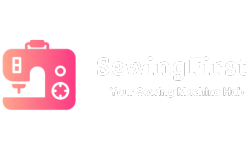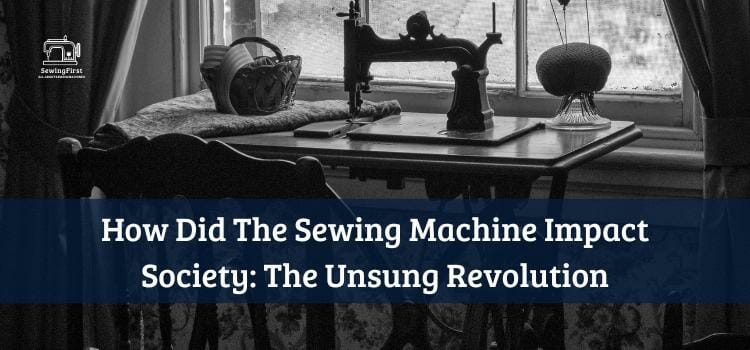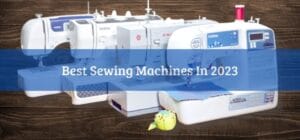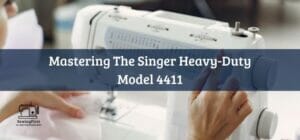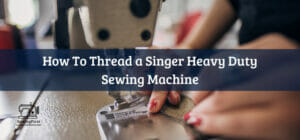Sewing a revolution for society, the sewing machine has been a powerful force in transforming our lives. Like a bolt of lightning, it struck swiftly and changed how people thought about fashion, industry, work, and women’s rights forever. In this article, we’ll explore how the sewing machine impacted society.
The history of the clothing industry before the advent of the sewing machine is one that was long and laborious; fabrics were crafted by hand with needles or even nails!
The process took days to complete and could only be done by those who had many hours available to devote to their craft – usually women. With the arrival of the sewing machine, however, things changed dramatically as clothing production suddenly became faster and more efficient than ever before.
Related Topic: How Much is an Old Kenmore Sewing Machine? Find Out Now! 2022
Table of Contents
ToggleOverview After the Sewing Machine Invention
In addition to its influence over fashion trends, industrial processes also benefited from this revolutionary device. From leather working to upholstery manufacturing, businesses across Europe and America now had access to high-quality machines that allowed them to produce goods at unprecedented speeds with superior quality control.
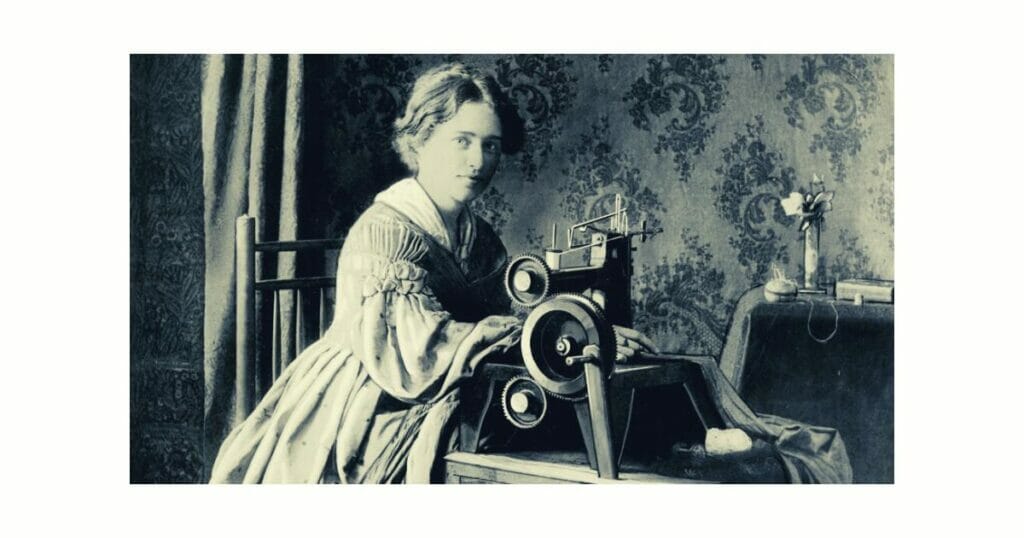
This led not only to increased productivity but also higher wages for workers who could spend less time crafting products due to improved efficiency enabled by the new technology.
Finally, perhaps most importantly, it provided a platform for greater emancipation among women as they began taking part in traditionally male-dominated industries such as shoe making and tailoring – something unheard of prior to the introduction of the mechanical marvel known as ‘the sewing machine’.
How did the Sewing Machine Impact Society: Early Efforts To 1846
In the early days of sewing, Elias Howe, Isaac Singer, Allen Wilson, and Nathaniel Wheeler were at the forefront of advancing innovation. Many developments in machinery had been made to improve production but none were as effective or efficient as the lockstitch sewing machine invented by Elias Howe.
This game-changing invention revolutionized both clothing production and garment design. Ready-made clothing became available on a much larger scale than ever before due to Howe’s patented technology.
Isaac Singer took what Howe had done one step further with his own version of the stitching machine known as “the first practical household sewing machine.” His device could be used with greater ease and speed than any other prior model.
It was also more affordable which helped make it popular among households everywhere. Alongside these inventions came Nathaniel Wheeler’s improved version that allowed for better portability so people could take their machines wherever they needed them to go.
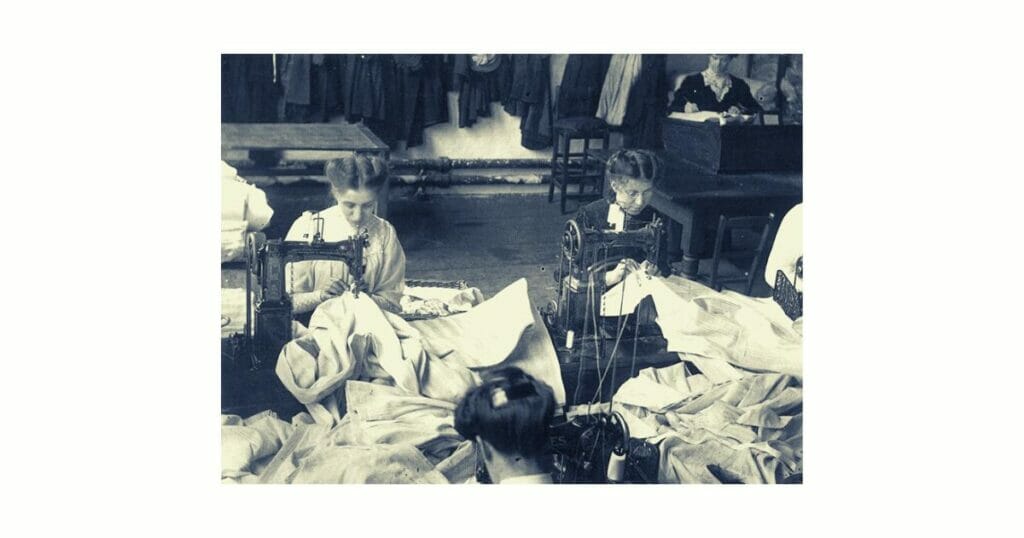
These three men played an integral role in making advancements in the field of apparel manufacturing by creating revolutionary devices that enabled the mass production of ready-made garments for all kinds of consumers around the world. With faster speeds and wider availability, this new form of fashion created a ripple effect throughout society that is still felt today.
The impact of these pioneering figures has been immense; from increased productivity to cost savings, their contributions have changed how we produce clothes forevermore – transforming our lives and lifestyles dramatically along the way. Their advances laid the groundwork for the modern-day fashion industry while giving us access to stylish wardrobe options like never before.
The Lawsuit: Howe’s Patent And The Sewing Machine Combine
Elias Howe’s revolutionary invention of the practical sewing machine was like a key unlocking the door to a new world of convenience and progress. It marked an unprecedented shift in society, from manual labor-intensive production to automated efficiency.
With Howe’s patent and Isaac Merritt Singer’s improvements added to the original design, these two men were about to change history with their combined efforts in creating a workable sewing machine for mass use.
In 1846, Howe visited Singer’s machine shop where he found that Singer had already made significant advancements in his own model. Even though they argued over who should take credit for certain parts of the invention’s construction, they eventually decided that it would be most beneficial if they worked together.
The result was a combination of both men’s designs which created what is now known as lock stitch: an efficient mechanism that could make stitches at any given length and strength using two threads instead of one.
The collaboration between Elias Howe and Isaac Merritt Singer resulted in great success when the first working prototype of their newly developed sewing machine was unveiled in Boston in 1851.
This intense partnership soon sparked further development among others interested in introducing this groundbreaking technology into everyday life – including Allen Wilson and Nathaniel Wheeler who improved upon its mechanics even more – yet only served to strengthen Howe and Singer’s joint claim over its invention by way of the lawsuit against those attempting to copy or replicate their design without permission or attribution.
Regardless of how it came about, there can be no denying that the modern sewing machine has been an incredible boon to humanity since its conception; improving productivity through automation while simultaneously providing economic opportunity for countless people around the globe whose lives have been forever changed due to its presence.
A journey we are still traveling today, all thanks to one fateful day back in 1846 when Elias Howes and Isaac Merritt Singer chose not just to cooperate but combine forces.
The Howe Sewing Machine Companies And The Singer Sewing Machine Company
The development of the sewing machine has revolutionized society for centuries. In the early 19th century, a man named Elias Howe devised and patented an industrial sewing machine that would eventually lead to powerful advances in garment industries around the world.
Following this invention, two companies emerged: The Howe Sewing Machine Company and Singer Sewing Machine Company.
These two entities have been instrumental in driving forward new advancements and modifications to Howe’s initial design. For example, electric machines were developed which allowed garments to be produced quickly with minimal effort.
This meant that clothing manufacturing could become more efficient than ever before and people had access to affordable apparel options due to the increased production speeds.
This further enabled garment industries worldwide to expand exponentially as they no longer needed manual labor or additional resources such as fuel or electricity for their operations. Additionally, these technological developments helped spur economic growth across many countries during the late 19th and 20th centuries.
As a result of this shift in practices, millions of jobs were created as well as improved standards of living for individuals who now had access to better quality goods at lower prices.
It is clear how immense an impact the development of the sewing machine has had on our modern-day societies—it has transformed our way of life forever.
From its roots in Howe’s original patent, we can now see just how massive an effect it has had on global economies by creating countless employment opportunities and making products more accessible than ever before.
With upcoming innovations like those from Merrow Sewing Machine Company continuing to license new versions of the sewing machine combined, we are sure to witness even greater changes ahead!
Merrow Sewing Machine Company And Number Of Sewing Machines Licensed By The Sewing Machine Combine
In the 19th century, the sewing machine was like a great wave of change that swept across society. It transformed daily life for people in so many ways, and all thanks to inventors, entrepreneurs, and companies who were part of this revolution. Two such companies were the Howe Sewing Machine Company and the Singer Sewing Machine Company – both giants in the industry.
But there was another company too: The Merrow Sewing Machine Company. By 1871, they had produced more than one million machines and held over 400 patents related to sewing machine technology. This success earned them a place among the members of the powerful Sewing Machine Combine – an industrial merger of 15 leading manufacturers at that time.
This marked a major shift in how middle-class women approached clothing production as commercial sewing machines became widely available from then onwards. It also represented a major step forward compared to earlier designs; most notably those patented by French tailor Barthélemy Thimonnier back in the 1830s whose work paved way for modern-day automation of textile manufacturing processes.
The rise of these three companies ushered in an era where women could become self-sufficient through their own small businesses or other ventures involving home-based garment-making activities without requiring large investments in traditional tools used before mass production became possible with the invention of these devices.
Furthermore, it allowed them to pursue financial freedom while saving considerable amounts of labor hours on certain tasks which would have otherwise been tedious and lengthy if done by hand.
This brought about significant economic opportunities not only for middle-class households but also helped create several jobs within industries associated with textiles and fashion design – something still seen today when we look around us at our current consumer culture
Sewing Machine Manufacturers Located In Connecticut, Including Brand Names
The emergence of the sewing machine has been a revolution in society. It’s no wonder that Connecticut was home to some of the most successful manufacturers, such as Merrow Sewing Machine Company and its impressive number of licensed machines by the Sewing Machine Combine.
What makes their products stand out are their original patents and innovative designs, including curved needles, barbed needles, patent models, and automatic feed mechanisms.
These advances have certainly made it easier for people to create clothing with less difficulty than ever before. The advantages to owning a quality sewing machine from one of these companies cannot be understated: time saved on each stitch allows for more delicate detail work or even faster turnarounds when required. With an increased emphasis on efficiency and cost-effectiveness, manufacturers in Connecticut provide exceptional value for money.
Not only do they produce reliable equipment but they also offer customer service options that go beyond simply selling you a product; they help train your staff so you can get the maximum benefit from using their machines. This holistic approach is what sets them apart from other competitors who may just sell something without giving any thought to how it will be used afterward.
This combination of high-quality machinery along with expertise and value makes buying a sewing machine from one of Connecticut’s leading brands an excellent choice in today’s market. Their products combine both modern technology and traditional craftsmanship into one package – ensuring satisfaction every step of the way while helping customers achieve their creative goals.
With this kind of commitment to excellence, it’s easy to understand why these companies have become industry leaders over the years. Moving forward into the future, we can expect great things from these pioneers of progress in Connecticut’s manufacturing sector – paving the way for others to follow suit.
The Willimantic Linen Company And The Sewing Machine
The Willimantic Linen Company, located in the small Connecticut town of Windham, had a profound impact on society through its revolutionary sewing machine design. From its humble beginnings as a 19th-century textile mill to one of the world’s leading manufacturers of industrial machines and electronic sewing machines by the 20th century, it was no surprise that this company changed the course of history.
At first glance, their sewing machine invention may seem like nothing more than an innocent tool for clothing alteration; however, upon closer inspection, we can see how much this machine truly reshaped our understanding of productivity and efficiency.
Its technology allowed people to complete tasks they were once unable to do at home or with manual labor alone – drastically reducing production time while expanding what could be done with fabrics and materials. This meant that garments could now be created faster and cheaper than ever before!
In addition to revolutionizing manufacturing processes, these machines also enabled people from all walks of life to partake in garment creation without having to learn intricate embroidery techniques – something that would have been otherwise impossible during the nineteenth century.
Moreover, with increased access came improved quality control for batches produced en masse. As such, clothes became not only more affordable but also better suited for daily wear thanks to the innovations brought about by this industry-leading company.
These advancements opened up a whole new realm of possibilities when it came to fashion and style: gone are the days when clothing was made solely for protection against harsh climates or other environmental factors!
Now anyone could get creative with colors, cuts, and textures as never seen before – allowing us greater freedom in expressing ourselves through fashion trends throughout the twentieth century and beyond.
The Rise Of The Middle Class And The Cult Of Domesticity
The sewing machine revolutionized society in ways that were previously inconceivable. Its impact on the lives of everyday people was nothing short of astronomical, ushering in a new era of convenience and efficiency that forever changed how we live our day-to-day lives.
From its inception as a crochet machine to modern sewing machines, technology has drastically altered the way we interact with the fabric, ultimately leading to a rise in the middle class and a cult of domesticity for women.
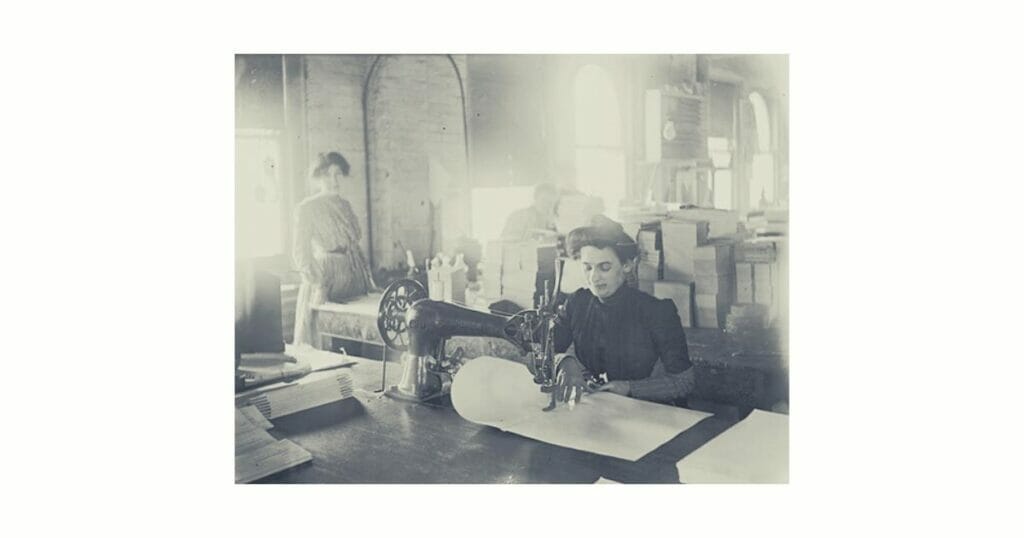
The introduction of the sewing machine had an immense impact on daily life throughout Europe and America during the nineteenth century. It allowed individuals to create clothing faster than ever before while also reducing costs associated with laborious hand stitching.
As such, this newfound ease quickly disrupted traditional cloth production industries and gave rise to larger-scale manufacturing processes where families could produce more garments at lower prices than they could have otherwise.
This resulted in increased household incomes among working-class families which propelled them into the growing middle class—a social group whose membership is largely attributed to the widespread use of sewing machines.
Concurrently, it established a “cult of domesticity” which saw housewives become increasingly involved in home management through activities like mending clothes or making furniture covers using their newly acquired sewing skills.
Women benefited from access to higher quality fabrics due to cheaper mass production techniques enabled by these crocheting and stitching machines; conversely, manufacturing companies experienced significant growth thanks to their ability to keep up with consumer demand while simultaneously lowering overhead expenses related to the manual labor force.
What emerged out of this period was an entirely different approach toward lifestyle: one characterized by practicality, comfortability, and affordability – all made possible through advances in sewing machine technology.
Nowadays, even those who lack knowledge about threading needles or cutting patterns find themselves able complete complex tasks effortlessly without having any prior experience – something unthinkable until only recently when considering how far humanity has come over time due solely to this revolutionary invention.
In fact, it would be safe to say that much of what defines us today can be traced back directly to the enormous cultural shift brought forth by the emergence of modern sewers decades ago–ushering us into a social revolution: The Sewing Machine and Seneca Falls
A Social Revolution: The Sewing Machine And Seneca Falls
The invention of the sewing machine changed the way people thought about clothing; it revolutionized the textile industry and heralded a new era in fashion. It also had an immense impact on society, transforming 19th-century culture and inspiring social movements for decades to come. From household machines to sweatshops, the development of this technology has been revolutionary.
Parallelism captures how quickly things began to change with the introduction of sewing machines: suddenly, clothing production was no longer limited by time or manpower. Not only did industrial-scale manufacturing become possible but women were able to conquer machines like never before.
This shift allowed them to work from home while taking care of their families – something that would be unthinkable without access to these powerful tools.
For many women living during this period, owning a sewing machine represented freedom and autonomy over their own lives. These devices meant they could earn money for themselves instead of relying solely on men as financial providers – thus giving rise to true economic equality between genders.
Today’s cult of domesticity can be traced back directly to the accessibility of affordable household machines in the mid-nineteenth century.
In addition, changes in the labor market brought about by the invention resulted in dramatic improvements within both the cloth and garment industries throughout Europe and America.
Workers now had better wages and conditions due to increased demand for products made using sewing machinery – providing much-needed relief from oppressive working environments such as those found in sweatshops at that time. The emergence of more ethical practices combined with greater efficiency fundamentally reshaped entire economies across continents into what we recognize today as modern capitalism.
The Sewing Machine In The Home: Women Conquer Machines
The sewing machine was the spark that ignited a social revolution. It ushered in a new era of advances, giving women more opportunities to become involved in everyday life and providing them with the power to shape their own destinies.
From its introduction into homes, it gave rise to mass production and enabled women to create cheap clothing for potential markets. This newfound capability changed society’s perception of what women are capable of, allowing them to carve out a place for themselves in an increasingly industrialized world.
It is impossible not to recognize the potential impact the sewing machine had on empowering women when looking at how far they have come since its invention over two centuries ago. Before this revolutionary tool came along, many households were reliant upon hand-sewing; tedious work that took days or even weeks depending on the garment being made.
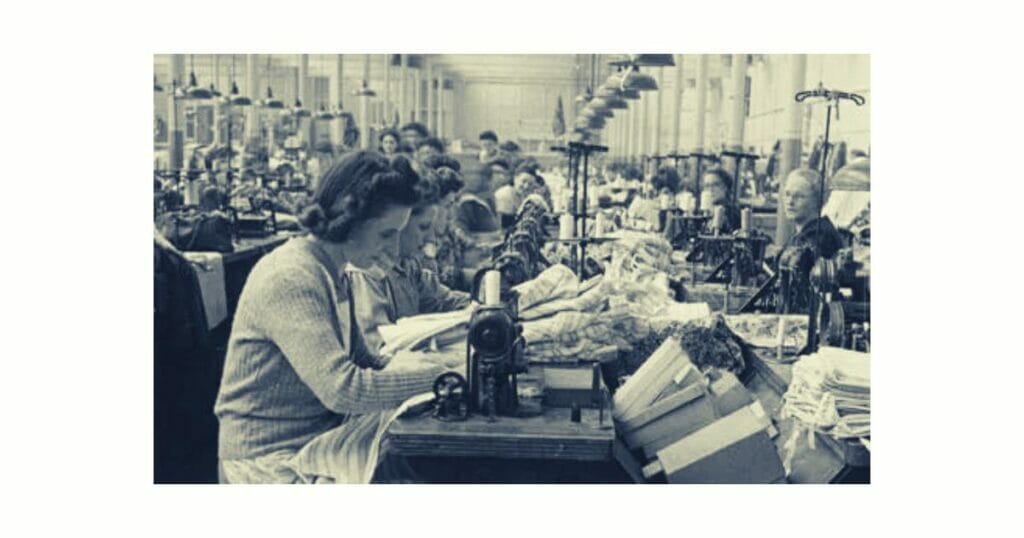
But by having access to such technology within their homes, women suddenly found themselves able to make clothes faster than ever before – drastically reducing the time needed compared to manual labor while also increasing quality as well.
Women could then use these skills to produce garments for ready markets and earn money from selling them – something which would never have been possible without the advent of this remarkable device.
However, thrifty housewives weren’t the only ones who benefited from this newly acquired ability – businesses soon caught wind of this powerful resource and began taking advantage of it too. Companies quickly realized there was a big market for cheaply produced clothing and sought out ways to capitalize on it through expanding factories full of female workers operating machines just like those used in people’s homes.
Although these jobs may sound appealing at first glance due to offering steady wages and decent working conditions, overtime hours and long shifts eventually lead some factories down a dark path where employees were subjected to unfair practices such as low pay or even child labor – transforming some places into sweatshops overnight.
At any rate, whether used by individuals or companies alike, one thing is certain – the sewing machine has left an indelible mark on our society today thanks largely in part to its transformative capabilities during the early stages of industrialization around 200 years ago.
Its influence continues still as men and women alike find themselves relying upon such tools every day; making it easier than ever before for everyone everywhere regardless of gender or age be able to craft unique pieces using modern materials that simply weren’t available back then.
With all that said, we can confidently move forward into exploring how this same technology impacted both working-class women specifically – particularly those living in poverty-stricken areas – from the cottage industry up until the present day.
From Cottage Industry To Sweatshops: Working Class Women And The Sewing Machine
The sewing machine revolutionized the way society worked, and with it came massive changes to the lives of working-class women. From cottage industry beginnings, the introduction of Amasa Howe’s revolutionary invention sparked a shift to sweatshops as its primary use.
This sweeping transformation had far-reaching implications for those in poverty, as well as broader repercussions on work culture at large.
At first glance, the sewing machine seemed like an opportunity too good to be true; a chance for poor women stuck doing piecemeal labor from home to move into more profitable factory settings.
However, this was not the case: while workers were able to produce clothing more quickly and cheaply than ever before, their wages often suffered due to competition for jobs and overcrowded workspaces.
In order to better understand how the sewing machine impacted society, consider these points:
- It enabled mass production of clothing and home furnishings – enabling people who could not afford expensive garments to purchase them at lower costs
- It allowed goods that would have previously been produced in small batches locally or by individuals’ own hands to now be made in larger quantities overseas
- Sweatshop conditions became widespread throughout industrialized societies thanks partly to the efficiency gains brought about by mechanization
- Working-class women filled newly available positions but faced exploitation including low pay and long hours.
Despite promises of improved economic opportunities for all involved, many laborers ended up worse off after the arrival of machines such as Howe’s design. The burden fell largely on female workers who found themselves subject to unfair treatment – something they had no choice but accept if they wanted employment at all.
With little power or recourse against unscrupulous employers, thousands were left struggling just to get by despite increased profits elsewhere in society. As we transition into looking at ‘the triangle fire, the sewing machine and movement for safe workplaces’, it is clear that much remains unresolved when it comes to equitable compensation for manual labor within developing nations today.
The Triangle Fire, The Sewing Machine, And The Movement For Safe Workplaces
The sewing machine is a powerful symbol of progress and transformation. It has been capable of creating drastic, revolutionary changes in the lives of many people. One such example is Barthelemy Thimonnier’s invention of one of the earliest machines in 1829 France.
This device would soon spread far beyond its beginnings: from producing uniforms for Napoleon’s army to being used as an essential tool in hundreds of different industries around the world.
Yet not all changes sparked by this device were positive ones. The tragic Triangle Fire in New York City was caused by workers using dangerous equipment, such as old-fashioned manual sewing machines that lacked safety regulations.
Workers suffered burns, cuts, exhaustion, and ultimately death due to these conditions – leading to calls for safer working environments across America.
These demands eventually led to new labor laws that created safe workplaces with improved ventilation systems and better wages for those who worked with sewing machines; factories had to adhere to strict fire codes, create aisles between workstations and install sprinkler systems where necessary.
In addition, more women than ever before began entering the workforce instead of staying at home due to increased job opportunities offered by sewing machines’ production lines.
This shift forever changed society’s view on female labor and helped bring about gender equality in the workplace – but it also presented some troubling implications regarding exploitation and unfair pay scales within certain industries like garment manufacturing.
Nevertheless, it can be said without doubt that the impact brought forth by sewing machines transformed history just as much as they revolutionized fashion.
Women’s Education: Home Economics And The Sewing Machine
The Industrial Revolution changed the world we live in. People moved from rural to urban environments, bringing with them a whole new way of life. But it wasn’t just technology that revolutionized society – women’s education also had an impact on how things were done.
The sewing machine was one tool that enabled people to create inexpensive clothing and transformed numerous domestic activities.
In contrast to the harsh reality of industrial labor conditions, home economics offered something much different: an opportunity for young women to learn useful skills without having to work in dangerous factories or mills.
With the advent of machines like the sewing machine, women could produce garments quickly at home and help support their families financially while still being able to manage household tasks. This opened up educational opportunities that had previously been closed off due to financial constraints or social stigma.
Home economics classes taught students skills related to cookery, cleaning, childcare, and garment-making; they provided practical knowledge as well as theoretical understanding about running a family home efficiently.
Sewing machines became increasingly popular among these female students as they allowed them to make cheap clothing out of fabrics that would otherwise have been too difficult or time-consuming for handcrafting alone.
This newfound access to cost-effective apparel not only improved quality of life but created employment opportunities for those looking for a job outside the factory system – such as seamstresses, tailors, and dressmakers – and fostered creativity within the fashion industry itself.
By becoming proficient in using this modern invention, more women could become independent economic forces who could contribute both inside and outside the home environment.
With the introduction of machines like the sewing machine into households across America came increased autonomy for women, providing them with invaluable tools that enabled them to take charge of their own lives by learning important skills for managing money and creating sustainable livelihoods through entrepreneurialism.
Women As Mechanics: Women’s Tools And The Sewing Machine
The sewing machine was a revolutionary invention that changed society in ways no one could have predicted. It not only allowed for the swift creation of clothing, but it also gave women unprecedented power and autonomy—they were now able to use tools as mechanics!
Women everywhere felt empowered by this newfound ability to craft their own clothes from start to finish. No longer did they need male tailors or cutters; instead, they had all the skills necessary right at home. Nowadays, we take this skill for granted, yet back then it was an incredible achievement that would help shape the future of gender equality.
It is important to note that prior to the invention of the sewing machine, many female-oriented jobs revolved around fabric production. With its introduction into homes worldwide, however, more and more women began taking up roles traditionally seen as “men’s work” like carpentry, plumbing and even machining.
This opened up whole new avenues for them – something which wouldn’t have been possible before due to limited access to certain trades or knowledge about how things worked. Moreover with increased access came increased wages – giving women greater economic freedom and independence than ever before.
Not only did the sewing machine change what kinds of jobs were available to women, but it also helped revolutionize fashion trends and styles of dress across different countries and cultures. Before its advent, people typically wore handmade garments which weren’t always consistent in quality or design – especially if made by amateur seamstresses without much experience or training.
But with the arrival of mass-produced clothing thanks to factories equipped with industrial sewing machines, standards became much higher and anyone could look fashionable regardless of their financial status or social standing.
This influence continues today through modern technologies such as 3D printing which allows designers to create customized apparel quickly and easily while still maintaining high levels of quality control over each product they produce – all thanks in part to advancements enabled by earlier inventions like the humble sewing machine!
Tailors And Cutters: Working Class Men And The Sewing Machine
For centuries, tailors and cutters used needles to make clothing for kings, queens, and other elites. But when the sewing machine arrived on the scene in 1846, it revolutionized how garments were made. Working-class men found opportunities that had never been available before – but what did the sewing machine really mean for them?
The impact of the invention was both practical and economic. In addition to significantly reducing the amount of time needed to sew a garment, it also allowed tailors to focus their attention on more intricate stitching techniques rather than having to worry about speed.
Furthermore, as demand rose for tailor-made clothing around the world, so too did wages – giving working-class men an unprecedented level of financial security they hadn’t previously enjoyed.
But beyond providing employment opportunities and higher wages, the sewing machine transformed society in another way: it gave working-class men access to tools that had once been seen as exclusively female instruments.
By allowing men into this traditionally female domain, new possibilities emerged – including greater respect from those who’d previously looked down upon manual labor.
This newfound empowerment would have a lasting effect on generations of workers; suddenly there was potential to not just survive but thrive in the ever-changing landscape of industry and economics.
The rise of gender equality brought by these transformations meant that all people could be part of creating something special out of nothing at all – paving the way for larger conversations about social change and progress yet to come.
Women As Consumers: Advertising And Selling Sewing Machines And Thread
The sewing machine was a revolutionary invention. It transformed the way we clothe ourselves, allowing us to stitch and tailor clothing faster than ever before. But one of its most impactful effects has been on women – it enabled them to become more independent in not only how they dress, but also how they manage their finances.
Advertising campaigns targeted towards women soon followed the introduction of the sewing machine; selling thread and machines to those who wanted to make their own clothes at home. This allowed them to save money and have control over what styles were used for themselves and their families.
As well as making life easier for many households, this newfound independence gave women an opportunity that had never before existed: financial freedom.
This new-found empowerment extended beyond just buying materials and doing household stitching — some even started businesses using their sewing skills! Women could now start up cottage industries, like tailoring or quilt-making with relative ease due to the speed and accuracy of the sewing machine.
Of course, these opportunities weren’t available equally across all demographics—but still, it meant more economic power was spread further amongst society than previously thought possible.
Thanks to increased advertising targeting female consumers, countless people found ways to create products from the comfort of their homes while maintaining financial autonomy. The sewing machine opened up possibilities that generations of women hadn’t enjoyed before—and continues to do so today.
Conclusion
The sewing machine has revolutionized the way we think of clothing, fashion, and even labor practices. It’s clear that the impacts of this invention are wide-ranging and still felt today.
At its core, the sewing machine allowed for mass production and automation in a way never seen before. This meant that people no longer had to hand sew their own clothes or rely on tailors to make garments – they could purchase them ready-made at a lower cost.
Women were especially enabled by the technology as it opened up educational opportunities through Home Economics classes while also providing employment opportunities as mechanics. Sewing machines have changed our lives by making the personal style more accessible than ever before.
In sum, We owe much credit to Elias Howe, Isaac Singer, Allen Wilson, Nathaniel Wheeler, and other pioneers who helped bring about such an incredible innovation!
FAQs
What impact did the sewing machine have on world history?
The sewing machine had a profound impact on world history. It revolutionized the textile industry, allowing for the mass production of clothing and other items. This in turn created new job opportunities and improved working conditions for many people.
It also enabled people to produce garments more quickly, reducing the cost of clothing. This helped to improve the quality of life for people who had previously relied on hand-sewn clothing and enabled them to purchase ready-made items at a fraction of the cost.
What is the impact of the sewing machine today?
The sewing machine is an incredibly important invention that has had a huge impact on the world today. It has revolutionized the way clothes and other textiles are made, greatly increasing productivity and making it easier and faster to create products. In addition, the sewing machine has made clothing and other textiles much more affordable, allowing people to access higher-quality products at a lower cost impact on the world today.
How did Isaac Singer’s sewing machine impact society?
Isaac Singer’s sewing machine revolutionized the clothing industry, making it much simpler and more efficient to create clothing. This had a massive impact on society, as an increase in the production of clothing allowed for more affordable prices, resulting in increased accessibility of clothing to the masses.
What is the most important in sewing machine?
The most important part of a sewing machine is the needle. The needle holds the thread and fabric together and helps to create the stitches.
What benefits can you get from sewing?
1. Improved Fine Motor Skills: Sewing helps to develop fine motor skills by teaching hand-eye coordination and dexterity.
2. Sense of Satisfaction: The satisfaction of completing a sewing project can be very rewarding.
3. Stress Relief: Sewing can be a great way to channel stress and relax.
4. Improved Creativity: Sewing can help to develop creativity as it involves problem-solving and artistic expression.
5. Cost Savings: Sewing can help to save money by creating customized garments or items for the home.
6. Self-Sufficiency: Sewing can help to foster self-sufficiency by teaching repair skills and the ability to create items from scratch.
What impact did the sewing machine have on quilting?
The invention of the sewing machine had a significant impact on quilting. It allowed quilters to quickly and accurately stitch together the pieces of the quilt top and to finish the edges of the quilt with a neat, even stitch.
What impact did the sewing machine have on quilting?
The invention of the sewing machine revolutionized the art of quilting. Prior to its invention, quilters had to stitch their quilts by hand, which was a slow and tedious process. With the sewing machine, quilters were able to complete their projects faster and with more accuracy. The sewing machine also allowed quilters to create more complex designs and patterns, as well as expand their creative potential with quilting.
How did the machine help the ladies?
The machine helped the ladies by allowing them to produce a higher quality product in a fraction of the time it would take them to do it by hand. It also allowed them to produce a larger quantity of products at one time, saving them time and effort.
